Staccato Dots – Why in a Space?

Why are Staccato Dots Placed in a Space?
Staccato Dots are introduced in the Ultimate Music Theory Prep 1 Rudiments Workbook. I thought it was a pretty simple concept...until my 7 year old student Jonathan started to ask "Why?".
- "Mme Shelagh, why does it have to be in a space?"
- "Why can't it be a really big dot?"
- "Why can't I write it on a line if I make it really dark?"
- "Why can't it be in the space above the notehead when the stem is up?"
- "Where does it go when the note is at the top or the bottom of the staff?"
This got me thinking - why does the staccato dot get placed where it is placed? What are the Ground Rules?
What is a Staccato Dot?
On Page 108 in Prep 1 Rudiments, we learn what a staccato is.

Ground Rules for Placement of Staccato Dots
The Ground Rules for placement of staccato dots are:
Ground Rule #1 - The staccato dot is always placed in a space.
Ground Rule #2 - The staccato dot is placed in the first empty space above the notehead when the stem goes down.
Ground Rule #3 - The staccato dot is placed in the first empty space below the notehead when the stem goes up.
Examples of Incorrect Staccato Dot Placements
Jonathan and I sat down and looked at what some incorrect examples of staccato dots look like. Then we analyzed each one to see why it was incorrect.
Example #1
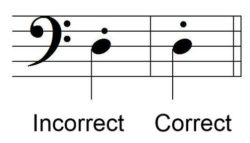
In the first measure, why is the staccato dot placement incorrect? The staccato dot is written on the line.
In the second measure, why is the staccato dot placement correct? Because the stem is down and the notehead is on a line, the staccato dot must be placed in the first empty space above the notehead.
The note is written on line #3, so the first empty space is space #4. Staccato dots cannot be written on lines. Why? A dot written on a line tends to blend into the line and is too hard to notice.
Example #2
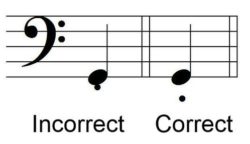
Incorrect measure: the staccato dot is touching the notehead.
Correct measure: the staccato dot is not touching the notehead.
To ensure that staccato dots are placed correctly and not "floating in outer-space", ask your student to picture a ledger line underneath the note. Then write the staccato dot in the space under that imaginary ledger line.
This will provide the correct placement for the staccato dot in the first empty space (and not "outer-space") below the notehead.
Example #3
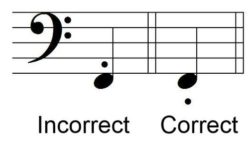
In measure 1, the staccato dot is in a space. It is in an empty space. But the stem is up. The staccato dot must be placed in the first empty space below a note when the stem is up. Notice that the first space above the notehead in measure 1 is not even empty - there is a stem line running through it!
Measure 2 shows the correct placement below the notehead. The staccato dot is placed far enough below the notehead that it is not too close, nor is it floating in outer-space. You could draw an imaginary ledger line under the notehead and the staccato dot would be placed correctly.
Example #4
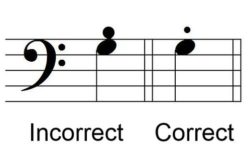
Jonathon liked this one! Yes, in measure 1, the staccato dot is in the space above the note. But wow, is it ever BIG!
Staccato dots should be written as a dot - not as a notehead without a stem. Although a measuring device is not going to be used to ensure that the dot is a specific size, students need to use their eyes to measure.
It can't be so big that it looks like another notehead, but it also can't be so small that the Teacher would require a magnifying glass to see it!
Example #5
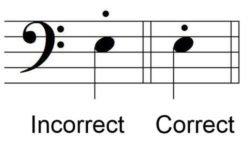
In this example, measure 1 has the staccato dot in an empty space. The stem is down, so the dot is in an empty space above the notehead...but is it in the first empty space above the notehead?
The correct measure shows the staccato dot in the first empty space above the notehead. Remind your students that not just any empty space will do - it must be the first empty space.
Exceptions to the Rules
Of course, when music has 2 separate voices on one staff, there are exceptions to the Staccato Dot Ground Rules...but I will save that for another blog!
For now, when adding staccato dots to notes, reminding students of the 3 Ground Rules will support them in placing their staccato dots correctly.
If, like me, you like to know and understand the "why" of theory concepts, please explore our website and Free Resources.
Learn more in the Teacher Training Online Courses Page. We have created these learning video courses specifically for busy teachers like you who also have a thirst for understanding "why".

Ultimate Music Theory Certification Course Online Teacher Training includes: 50 Video Sessions, All Materials, Online Support,
Exam Marking & Certificate!
Click HERE to discover what you will learn in the Ultimate Music Theory Certification Course. Your professional development Online Teacher Training starts here.
Keep on Learning... With a Smile and a Song!
Shelagh McKibbon-U'Ren

